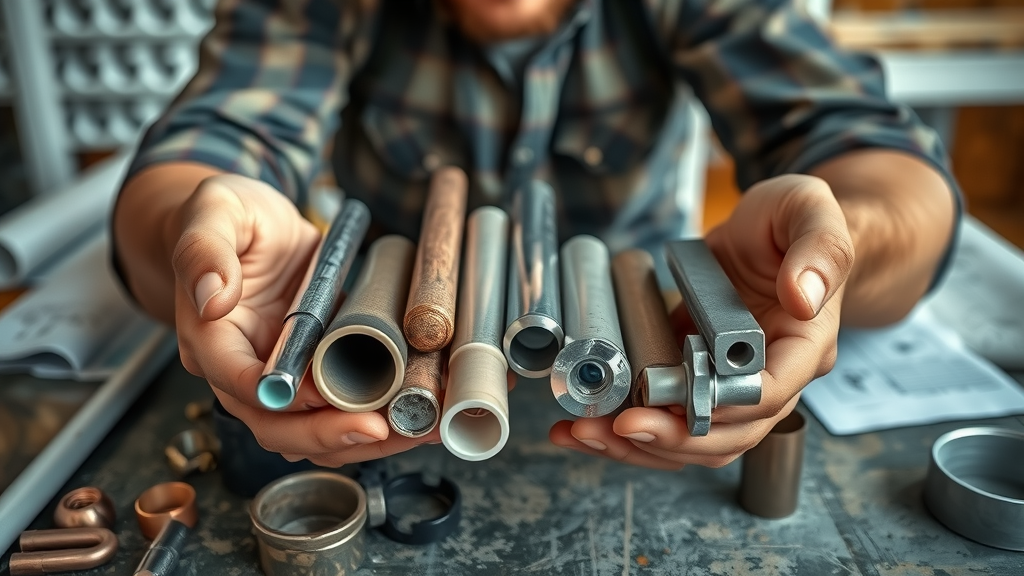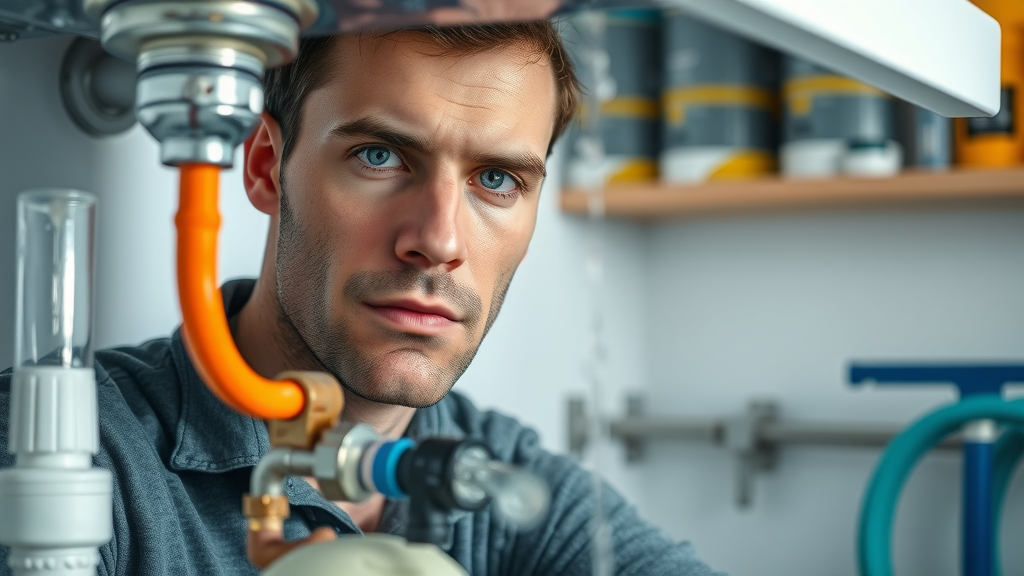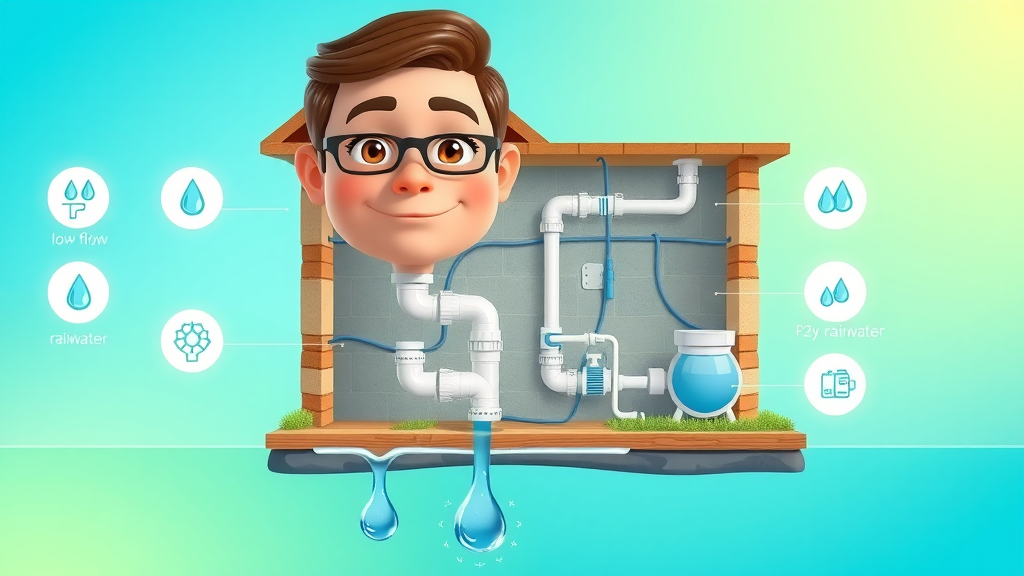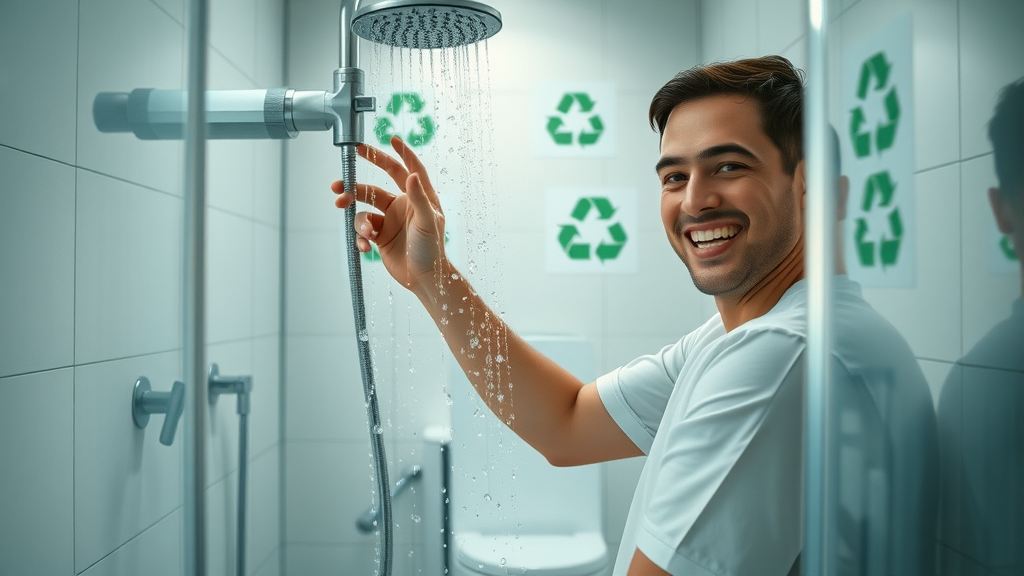Did you know the Environmental Protection Agency reports that households can slash water bills by up to 20% just by installing water-efficient plumbing materials? It’s not just about saving the planet— sustainable plumbing materials can lead to significant savings while making your home more comfortable and future-proof. In this comprehensive guide, you’ll discover how switching to eco-friendly plumbing solutions can transform your home’s efficiency, your wallet, and your peace of mind. Read on to learn exactly how modern plumbing systems, energy-efficient water heaters, and emerging piping materials can be your ticket to a greener, more affordable home.
Discover How Sustainable Plumbing Materials Can Revolutionize Your Home
The most popular sustainable plumbing materials and their advantages
How eco-friendly plumbing solutions save money and resources
Key innovations and trends in sustainable plumbing systems
Practical steps for upgrading your plumbing materials
According to the EPA, households can save up to 20% on water bills by installing water-efficient plumbing materials and fixtures.

Modern sustainable home, cheerful homeowners examining new plumbing fixtures, eco-friendly kitchen.
Unpacking Sustainable Plumbing Materials: Definitions, Types, and Importance
What makes plumbing materials sustainable?
Sustainable plumbing materials are designed to minimize environmental impact, conserve resources, and last longer than conventional options. These materials are either renewable, easily recyclable, or manufactured with low carbon emissions. For example, PEX pipe and recycled steel represent piping materials with both low energy requirements for production and high longevity. Bio-based plastics, bamboo, and clay further reduce toxic output and resource depletion in the construction of modern plumbing systems. By considering the entire lifecycle from production to disposal, sustainable plumbing ensures water distribution and drinking water systems stay efficient and environmentally friendly.
Choosing materials like copper pipe, stainless steel, and PEX also means fewer repairs, less water waste, and healthier potable water thanks to reduced chemical leaching. These advancements set the foundation for eco-friendly plumbing solutions that don’t just save money—they also protect future generations by reducing pollution and resource extraction. Ultimately, by adopting sustainable plumbing solutions, homeowners actively reduce their carbon footprint and support broader water conservation efforts.

Hands holding PEX, copper, steel, and bio-based plastic pipes on eco-friendly workbench.
Key benefits of sustainable plumbing for homeowners
Embracing sustainable plumbing materials comes with a host of benefits for homeowners. First, materials like PEX pipe and copper offer remarkable durability, which translates into fewer leaks, repairs, and replacements over the years. This not only cuts down on maintenance costs but also ensures your plumbing system remains highly reliable. Additionally, efficient materials and cutting-edge technologies—such as tankless water heaters and low-flow fixtures—support water conservation, significantly lowering your monthly water usage and energy consumption.
Furthermore, sustainable plumbing materials support better indoor air and water quality. By opting for recyclable and non-toxic pipe material, such as recycled steel and bio-based PVC, you can reduce your exposure to harmful chemicals and improve the quality of your drinking water. These materials also contribute to a healthier home environment, further boosting your property’s long-term value. Finally, using sustainable options demonstrates a commitment to environmentally friendly living, making your home more attractive to eco-conscious buyers if you ever decide to sell.
Comparison of Common Sustainable Plumbing Materials | |||
Material |
Lifespan |
Cost Savings |
Environmental Impact |
|---|---|---|---|
PEX Pipe |
40+ yrs |
High |
Low Carbon Footprint |
Copper |
50+ yrs |
Moderate |
Recyclable, Expensive |
Recycled Steel |
70+ yrs |
Varies |
Highly Sustainable |
Bio-based PVC |
25+ yrs |
Good |
Reduced Toxicity |
Top Sustainable Plumbing Materials for Eco-Friendly Plumbing Solutions
PEX Pipe: The Modern Choice For Energy-Efficient Plumbing Systems
PEX pipe is quickly becoming the go-to piping material for sustainable plumbing systems. Its flexibility allows installers to run continuous lines without many joints, greatly reducing the chance of water leaks and limiting potential weak points in your plumbing network. As a result, water usage in the home is more efficient and the system’s overall durability is much higher compared to traditional options. PEX pipe is also known for its longevity, often exceeding 40 years of service with minimal degradation.
Durability
Flexibility
Reduced water leaks
Energy efficiency
One often overlooked benefit of PEX pipe is its ability to support energy efficiency within your water system. Since PEX has insulating properties, it helps maintain hot water temperatures longer as it travels between your water heater and outlets. This means you spend less energy to heat water, driving down your utility bills. Coupled with its ease of installation and cost-effectiveness, it’s no surprise that PEX is recommended by plumbing professionals worldwide for those seeking plumbing solutions that are both environmentally friendly and budget-conscious.

Colorful PEX pipes installed under a modern sink, showcasing durability and water efficiency.
Copper: Traditional and Recyclable Plumbing Material
Copper pipe remains a classic choice in plumbing systems for its remarkable strength, resistance to corrosion, and natural antibacterial qualities. Its long lifespan—often spanning over 50 years—makes it a valuable investment for any homeowner seeking reliable and sustainable plumbing. Advance in recycling technologies means that most new copper pipes contain a significant amount of recycled material, aligning with eco-friendly objectives. Furthermore, copper is 100% recyclable, which directly contributes to lower resource extraction and reduced environmental impact at the end of its life cycle.
Not only does copper support the integrity of your potable water, but it’s also recognized for maintaining high water quality without imparting harmful substances. Though copper is generally more expensive upfront than some alternative materials, its proven track record for safety, performance, and recyclability still makes it one of the most sustainable plumbing materials you can choose. As part of a balanced plumbing system, copper complements other eco-friendly components, from advanced water heaters to innovative filtration systems, for comprehensive water conservation.
Stainless and Recycled Steel: The Sustainable Option for Modern Plumbing
Stainless steel and recycled steel pipes are rising stars in the sustainable plumbing arena. These piping materials are engineered to withstand corrosion and handle extreme temperatures, making them ideal for both residential and commercial plumbing systems. Beyond their physical advantages, steel pipes—especially those made from post-consumer recycled content—carry one of the lowest environmental footprints among plumbing solutions. With the ability to last over 70 years, recycled steel offers extended longevity that rivals or exceeds copper and PEX.
What sets steel apart is its closed-loop recyclability; pipes at the end of their life can be reprocessed into new plumbing materials or other useful products, minimizing landfill waste. This makes steel especially valuable for green building projects or any homeowner looking to significantly cut their carbon footprint. Whether used for water distribution, hot water, or heating system infrastructure, steel pipes deliver sustainability side by side with unbeatable durability—even in challenging climates.
Bio-Based Plastics And PVC Alternatives For Friendly Plumbing Applications
Bio-based plastics and new-generation PVC alternatives are breaking ground in eco-friendly plumbing solutions . Made from renewable plant-based sources such as corn or sugarcane, these materials drastically reduce the amount of fossil fuel required for piping production. Unlike traditional PVC, bio-based variants minimize the use of heavy metals and eliminate harmful plasticizers, leading to improved indoor air and water quality. These alternatives are perfectly suited for greywater, rainwater harvesting, or potable water applications where health and sustainability are paramount.
Although bio-based plumbing materials generally have a shorter lifespan compared to copper or steel, the latest innovations have improved their performance and durability considerably. They offer good resistance to scale and chemical buildup, and their light weight makes for easy installation and reduced shipping emissions. For homes aiming to maximize both water conservation and environmental responsibility, bio-based and PVC-alternative pipes present a smart, healthy plumbing solution.
Emerging Natural Plumbing Materials: Bamboo, Clay, and Others
Natural materials like bamboo and clay are beginning to reshape perceptions around sustainable plumbing. Bamboo, lauded for its rapid regrowth and exceptional strength-to-weight ratio, is a renewable resource that can be engineered into durable piping systems for non-potable water use. Clay pipes—used for centuries in water systems—are regaining popularity for their chemical-free nature and resistance to root intrusion, especially in drainage and sewer applications.
These environmentally friendly piping materials are not yet mainstream, but they are gaining attention among green building professionals. While natural materials may be best suited as part of a hybrid plumbing system or for select friendly plumbing applications, their role in the sustainable plumbing movement continues to expand as new innovations emerge.

Natural bamboo and clay pipes showcased with sustainable architecture elements.
Comparing Plumbing Systems: Conventional vs Sustainable Plumbing
Conventional vs. Sustainable Plumbing Systems | ||
Feature |
Conventional |
Sustainable |
|---|---|---|
Water Usage |
Higher |
Reduced up to 40% |
Material Longevity |
Moderate |
Extended lifespan |
Upfront Cost |
Lower |
Slightly higher |
Long-Term Savings |
Limited |
Significant |
Water Conservation in Sustainable Plumbing Materials
How sustainable plumbing materials reduce water usage and waste
One of the core benefits of using sustainable plumbing materials is their significant contribution to water conservation. Eco-friendly fixtures and piping materials, such as low-flow faucets, PEX pipe, and modern dual-flush toilets, minimize unnecessary water flow without sacrificing user comfort. These innovations ensure that every drop is used thoughtfully, helping homeowners reduce water consumption by up to 40% compared to conventional plumbing systems. By upgrading your plumbing materials and integrating advanced water system designs, you help safeguard the world's most valuable resource—water—while simultaneously lowering your bills.
Modern plumbing systems also incorporate leak-detecting technology and pressure-regulated valves as part of their water conservation toolkit. Together, these advancements work seamlessly in the background to prevent water waste, keep your energy efficiency high, and extend the lifespan of your plumbing infrastructure. As part of a holistic approach to sustainable plumbing, these improvements make the friendly plumbing experience not just possible—but practical and affordable in everyday life.

Infographic cross-section of plumbing system showcasing water conservation features and eco-friendly plumbing materials.
Plumbing system upgrades for water conservation
Upgrading your plumbing system to incorporate sustainable plumbing materials can be as comprehensive or as targeted as you wish. Homeowners often start with simple retrofits, such as swapping old showerheads for low-flow models or installing aerators on faucets to curb water usage instantly. For greater impact, consider replacing aging pipes with PEX or recycled steel for enhanced durability and reduced water waste. Such upgrades not only cut water bills but also shrink your home's environmental impact and carbon footprint.
Don’t overlook the role of smart technologies. Innovations like Wi-Fi-enabled leak detectors, programmable irrigation timers, and greywater recycling systems ensure your plumbing solutions are efficient and sustainable. By planning these upgrades systematically, you’ll see cumulative savings in both energy and water, all without sacrificing convenience or comfort. These changes are investments that pay for themselves—often sooner than you’d expect!
‘The best investment for the future of our planet is sustainable water solutions in every home.’ – Green Building Council
Smart Plumbing Solutions: Tankless Water Heaters and Advanced Water Heaters
Tankless water heater: Efficiency and sustainability
Tired of hot water running out and sky-high energy bills? Tankless water heaters have rapidly gained popularity in sustainable plumbing systems as the ultimate solution for efficiency and convenience. Unlike conventional heaters that keep a massive tank heated around the clock, tankless water heaters only heat water on demand—slashing standby energy losses and reducing your home’s carbon footprint. This on-demand heating not only means unlimited hot water for your family but also marked improvements in energy efficiency and overall sustainability.
Water heating innovations for reduced water usage
Unlimited hot water
Lower energy bills
Smaller carbon footprint
The latest water heating innovations leverage smart controls to maximize heat water efficiency. Hybrid models combine the speed of tankless units with the stability of traditional systems, while heat pump water heaters extract warmth from surrounding air—using up to 60% less electricity compared to standard water heaters. These upgrades make a noticeable difference both in reducing water waste and trimming household energy usage. For homeowners committed to water conservation and eco-friendly plumbing, advanced water heaters are a top priority for a greener home.

Contemporary utility room with tankless water heater and energy-efficient appliances.
Eco-Friendly Plumbing Fixtures to Complement Sustainable Plumbing Materials
Low-flow fixtures: Saving water without compromise
Low-flow fixtures, such as toilets, faucets, and showerheads, are game-changers for homeowners aiming to make their water system more friendly to the environment. They dramatically reduce water flow—sometimes by as much as half—without compromising user experience or hygiene. Modern low-flow plumbing solutions use air injection, pressure control, and innovative design to ensure a powerful wash while using far less water. This not only supports water conservation but also helps lower your utility bills, providing an immediate and noticeable return on investment.
Greywater systems and rainwater harvesting for friendly plumbing
Greywater systems capture wastewater from showers, sinks, and laundry, treating it for safe reuse in irrigation or toilet flushing. This sustainable plumbing approach can slash your drinking water consumption, lessen your reliance on municipal water supplies, and further cement your commitment to eco-friendly living. Similarly, integrating rainwater harvesting capabilities in your plumbing system lets you utilize captured rain for flushing, watering gardens, or even laundry, providing an additional layer of resource efficiency to your home.

Modern bathroom featuring low-flow fixtures and visible eco-friendly plumbing systems.
The Environmental and Economic Impact of Sustainable Plumbing Materials
Carbon footprint reduction with modern plumbing materials
Switching to modern, sustainable plumbing materials is an effective way to reduce your home’s carbon footprint. Each sustainable option—whether it’s PEX pipe, copper, steel, or innovative bio-based plastics—shrinks the effects of manufacturing, transport, and eventual disposal of traditional piping material. These eco-friendly choices support a broader movement in green building, ensuring every aspect of your plumbing system contributes positively to environmental conservation. With lower emissions and resource requirements, sustainable plumbing becomes a concrete action against climate change.
Long-term cost savings from sustainable plumbing system investments
Investing in sustainable plumbing systems might require a higher upfront outlay, but the payoff in long-term savings is undeniable. Durable materials need fewer repairs, last longer, and waste less water, resulting in considerably lower operating and maintenance costs. As utility prices continue to rise, efficient fixtures, piping, and advanced water heaters will shield your household budget from future increases. Ultimately, sustainable plumbing solutions offer a compelling mix of improved performance, peace of mind, and financial benefits that can’t be matched by conventional systems.
Lower greenhouse gas emissions
Reduced resource extraction
Better indoor air and water quality
How to Choose the Right Sustainable Plumbing Materials for Your Home
Factors to consider when selecting plumbing materials
When choosing sustainable plumbing materials, it is vital to assess your home’s specific needs, climate, and water quality. Materials like PEX and copper excel for potable water systems, while stainless steel or recycled steel might be better suited to high-pressure or industrial use. Consider compatibility with existing fixtures and possible local water chemistry issues—some materials perform better in hard water conditions than others. Always factor in both initial cost and lifetime value as well as recyclability, toxicity, and longevity.
Working with plumbing professionals for eco-friendly results
No sustainable plumbing project is complete without consulting with a plumbing professional. Their experience ensures that new piping materials are installed correctly and integrated seamlessly into your plumbing system. Not only can professionals guide you through local code requirements and optimal solutions for your space, they’ll help you avoid compatibility risks and costly future repairs. A certified sustainable plumbing expert can recommend the best combination of eco-friendly materials, smart plumbing fixtures, and advanced water system management tools for lasting results.
Evaluate current plumbing materials
Identify areas for sustainable improvement
Research and select eco-friendly options
Consult with a sustainable plumbing expert
Trends and Innovations in Sustainable Plumbing Solutions
The newest plumbing materials and technologies transforming the industry
Technological breakthroughs drive the evolution of sustainable plumbing. Innovations like bio-based plastics—offering strength, flexibility, and low toxicity—are gaining widespread adoption. Advanced PEX formulations and hybrid composites combine different sustainable materials for maximum longevity and minimal environmental impact. Smart leak detectors, remote monitoring apps, and automated shut-offs are making plumbing systems more resilient, responsive, and efficient. These trends ensure the future of friendly plumbing systems remains bright, practical, and impactful for eco-conscious homeowners.
Smart water system integration for modern, efficient homes
Integration of smart technologies is shaping the next generation of plumbing solutions. With smartphone apps monitoring water usage, pressure, and leaks, homeowners gain real-time insight and control over their entire plumbing system. Automated valves and programmable water heaters further streamline performance, drastically reducing water waste and improving energy efficiency. Not only do these technologies offer peace of mind, but they also validate your investment in sustainable plumbing by quantifying water and cost savings over time.

User monitoring a smart plumbing system via app, controlling smart water valves in a modern, efficient home.
Challenges and Considerations with Sustainable Plumbing Materials
Upfront investment versus long-term rewards
Many homeowners face sticker shock when first considering sustainable plumbing upgrades. PEX, recycled steel, and advanced fixtures can cost more than standard PVC or older metal pipes. Yet the key is recognizing these as investments: the substantial long-term benefits—lower utility bills, fewer repairs, and higher property value—far outweigh initial costs. Financial incentives, rebates, and tax credits may also help reduce the upfront impact of choosing eco-friendly plumbing solutions.
Potential installation and compatibility issues
Sustainable plumbing materials may sometimes pose installation hurdles, especially when retrofitting older homes. Some pipe materials have specific installation requirements or may not mesh directly with legacy plumbing systems. It’s essential to work with experienced professionals who understand these materials and can design a solution tailored to your home. Correct installation is crucial for performance, water conservation, and maintaining warranties.
Maintenance tips for eco-friendly plumbing materials
Maintaining sustainable plumbing systems is generally straightforward, but regular inspection and timely repairs are crucial to ensure optimal performance. Check for leaks, monitor water pressure, and clean aerators and filters as needed. For specialized materials like bio-based plastics or advanced composites, consult manufacturer maintenance guides and your plumbing professional to preserve both longevity and performance. Staying proactive with friendly plumbing maintenance protects your investment and ensures you maximize economic and environmental returns.
Visual Guide: Sustainable Plumbing Materials in Real-World Homes (Video)
A walkthrough of several real-world homes showcasing sustainable plumbing materials and systems in action, narrated by a professional plumber, including before-and-after comparisons and performance metrics visualizations.
Expert Installation Tips for Sustainable Plumbing Materials (Video)
Expert installation tips for sustainable plumbing materials, with step-by-step visual guidance from industry professionals.
What are the sustainable materials for plumbing?
Answer: Sustainable materials for plumbing include PEX pipe, copper, recycled steel, bio-based plastics, bamboo, and clay, chosen for longevity, low environmental impact, and recyclability.
What are the 5 plumbing materials?
Answer: The five common plumbing materials are PEX, copper, PVC, steel (often recycled), and CPVC, each offering different sustainability and performance benefits.
What is eco in plumbing?
Answer: Eco in plumbing refers to materials, systems, and fixtures designed to reduce water and energy consumption, minimize waste, and protect the environment.
What is the newest plumbing material?
Answer: The newest plumbing materials include bio-based plastics, advanced PEX formulations, and hybrid composites designed for increased sustainability and efficiency.
Frequently Asked Questions About Sustainable Plumbing Materials
Which plumbing materials last the longest? Among plumbing materials, recycled steel can last over 70 years, copper typically endures 50+ years, and PEX can provide over four decades of reliable service, making these excellent choices for longevity and sustainability.
Are sustainable plumbing materials expensive? Sustainable plumbing materials may have a higher purchase price compared to conventional options, but their extended lifespan, water conservation, and reduced maintenance expenses often lead to significant long-term savings.
Can I retrofit my old plumbing system with eco-friendly materials? Yes, most existing homes can be retrofitted with sustainable plumbing materials. Consulting a professional ensures compatibility and smooth integration with your current system, maximizing water efficiency and sustainability.
Will eco-friendly plumbing improve my home’s value? Absolutely. Energy efficiency, water savings, and reduced environmental impact add value for potential buyers, making homes with sustainable plumbing solutions more attractive and potentially raising resale prices.
Key Takeaways: Why Choosing Sustainable Plumbing Materials Is a Smart Investment
Sustainable plumbing materials reduce water usage and costs
Modern plumbing systems are more reliable and better for the environment
Eco-friendly plumbing solutions can increase property value
Ready to Transform Your Plumbing System?
For expert help or advice from Ed Serrell Plumbing and Heating call tel:0796 688 4368 , or email info@edsplumbing.co.uk
Conclusion
Make the switch to sustainable plumbing materials—evaluate your options, consult an expert, and start saving money while protecting the environment today. Your eco-friendly future begins with smarter plumbing choices!
Sources
Green Building Council – https://www.greenbuildingcouncil.org.uk
Plumbing Foundation – https://www.plumbingfoundation.org/sustainability/
To further enhance your understanding of sustainable plumbing materials and their benefits, consider exploring the following resources:
The article “ Guide To Choosing Eco-Friendly Plumbing Products ” provides insights into various sustainable materials, including bamboo and recycled plastic pipes, and their advantages in modern plumbing systems.
“ Discover eco-plumbing ” discusses the use of polypropylene pipes and fittings, highlighting their corrosion resistance, lightweight nature, and recyclability, contributing to eco-friendly plumbing solutions.
These resources offer valuable information on selecting and implementing sustainable plumbing materials to create a more efficient and environmentally friendly home.
 Add Row
Add Row  Add
Add 




Write A Comment